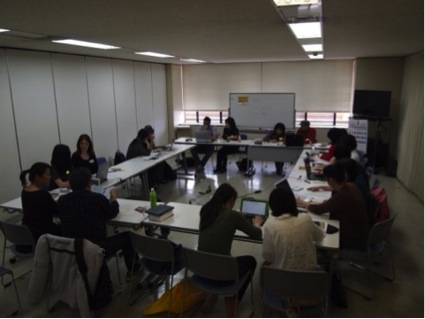WIT Life #282: あけおめことよろ!
WIT Life is a periodic series written by professional Writer/Interpreter/Translator Stacy Smith (Kumamoto-ken CIR, 2000-03). She starts her day by watching Fujisankei’s newscast in Japanese, and here she shares some of the interesting tidbits and trends along with her own observations.
Happy New Year! The greeting in the title is an abbreviation of 「明けましておめでとうございます!今年もよろしくお願いします。」 (“Akemashite omedetou gozaimasu! Kotoshi mo yoroshiku onegai shimasu.”). We all know how much the Japanese love their abbreviations! I hope everyone had a fun and relaxing 年末年始 (nenmatsu nenshi, or year-end and new year), and are ready and refreshed for 2015. We are now in the year of the sheep, so for all of you with this animal sign this is your year.
The Abe administration is also hoping it is the year for women, coming off of his disastrous efforts in this arena last year with the resigning of two female ministers and general skepticism in regard to his Womenomics agenda. There was an interesting Read More
WIT Life #281: 今年の漢字
WIT Life is a periodic series written by professional Writer/Interpreter/Translator Stacy Smith (Kumamoto-ken CIR, 2000-03). She starts her day by watching Fujisankei’s newscast in Japanese, and here she shares some of the interesting tidbits and trends along with her own observations.
In a follow-up to yesterday’s post about the top 10 buzzwords in Japan this year, the country’s “kanji of the year” was just announced. 税 (zei) or tax was selected, referring to the consumption tax increase from 5% to 8% in April. The last time the tax had gone up was in 1997 when it went from 3% to 5%. Prime Minister Abe had to decide by the end of the year whether it would be further increased to 10% next year as planned, but he decided to delay this course of action to a later point in time. The selection of 税, along with the other top candidates, indicates a mood of anxiety and uncertainty in Japan.
Coming in at #2 was 熱 (netsu), meaning heat, fever or passion. This points to Read More
WIT Life is a periodic series written by professional Writer/Interpreter/Translator Stacy Smith (Kumamoto-ken CIR, 2000-03). She starts her day by watching Fujisankei’s newscast in Japanese, and here she shares some of the interesting tidbits and trends along with her own observations.
Every year Japan picks the top 10 buzzwords for the year, out of an initial pool of 50 nominated phrases. You can find the list and explanation of selections in Japanese here, and below I will break them down as well. The annual grand prize was awarded to ダメよ~ダメダメ (dame yo, dame dame), a phrase popularized by the female comedy duo Nippon Erekiteru Rengo, and 集団的自衛権 (shuudanteki jieiken), or the right to collective self-defense. The former is a way of lightly turning someone down, particularly when you are asked to do something you aren’t able to do but can’t completely refuse. The latter highlights the controversial decision by Prime Minister Abe’s Cabinet to change the government’s interpretation of the pacifist Constitution to enable Japan to engage in collective self-defense. The remaining eight picks can be found below, so why not incorporate some into your conversations to impress Japanese friends?
• カープ女子 (Carp joshi): female fans of the Hiroshima Carp baseball team
• レジェンド (rejendo): refers to veteran ski jumper Noriaki Kasai, who by Read More
WIT Life #279: 東京家族
WIT Life is a periodic series written by professional Writer/Interpreter/Translator Stacy Smith (Kumamoto-ken CIR, 2000-03). She starts her day by watching Fujisankei’s newscast in Japanese, and here she shares some of the interesting tidbits and trends along with her own observations.
I can’t believe I haven’t posted here in over a month, though I think I know part of the reason why. Last month TV Japan offered a free two-week viewing period of its programming for non-subscribers. During this time I got used to watching this 24-hour Japanese channel, particularly its wide array of news shows that are really useful for learning vocabulary for interpreting. The service is through NHK Cosmomedia America, and will be very familiar to those of you who followed NHK’s programming in Japan. There are multiple daily news shows, including internationally focused ones and one I really like called Today’s Close-Up (現代クロースアップ) which takes a deep dive into a particular subject. For $25 a month you can be immersed in the world of Japan, so I immediately became a subscriber when the trial period ended (TV Japan is offering a $50 rebate if you sign up before the end of the year and maintain your subscription for at least three months!). I’ve not only been studying via the news but also getting back into Read More
WIT Life #278: High Speed Rail Plan (via the Onion)
WIT Life is a periodic series written by professional Writer/Interpreter/Translator Stacy Smith (Kumamoto-ken CIR, 2000-03). She starts her day by watching Fujisankei’s newscast in Japanese, and here she shares some of the interesting tidbits and trends along with her own observations.
Apropos of nothing, can’t resist sharing this gem from the Onion. I love how they use the actual train names/types. 良い3連休を!
WIT Life #277: Garden of Unearthly Delights
WIT Life is a periodic series written by professional Writer/Interpreter/Translator Stacy Smith (Kumamoto-ken CIR, 2000-03). She starts her day by watching Fujisankei’s newscast in Japanese, and here she shares some of the interesting tidbits and trends along with her own observations.
As a member of Japan Society, last night I had the chance to preview the new gallery exhibition Garden of Unearthly Delights. It featured works from two artists and the collaboration teamLab that were largely fantastical with a strong dose of social commentary. As a result, it felt like a very dense exhibit that seemed to occupy more space than the gallery’s actual square footage. 
Garden begins with works from Manabu Ikeda, an artist originally from Saga Prefecture who now resides in Madison, Wisconsin after previously living in Vancouver. The focus of his paintings in this show are on disaster art and 311, an event he witnessed from outside the country. You can see many manga and anime-like aspects in them as well. I particularly liked his work Foretoken, which is often compared to Hokusai’s The Great Wave off Kanagawa, displayed nearby in the gallery. Upon close inspection you can see the intricate detail of his infinite brushstrokes, but when you look at it from a distance you get a whole other perspective. Underneath the huge wave that is cresting you can find things like Read More
WIT Life #276: San Diego’s San-Kei-En garden
WIT Life is a periodic series written by professional Writer/Interpreter/Translator Stacy Smith (Kumamoto-ken CIR, 2000-03). She starts her day by watching Fujisankei’s newscast in Japanese, and here she shares some of the interesting tidbits and trends along with her own observations.
My interpreting gig continues westward, and I am currently with my interpreting clients in San Diego. It was my first time here in a while, and I was looking forward to seeing what Japanese connections awaited. As a result, I was happy to have some time in between appointments to visit the Japanese Friendship Garden in Balboa Park with my group. It’s official name is 三景園 (“San-Kei-En”), which means Water, Pastoral and Mountain. San Diego’s sister city in Japan is Yokohama, and the garden was designed to be an expression of the ties between the people of the two cities. Its gate is dedicated to Charles C. Dail, the former Mayor who began this sister city program in 1957.
Classes offered at San-Kei-En include ikebana, origami, bonsai and tea ceremony. The original Japanese tea house in Balboa Park had an interesting story. It was built for the Panama-California Exposition in 1915, and when the city couldn’t operate it post-exposition a Japanese couple managed it until 1941. Read More
WIT Life #275: DC’s Daikaya
WIT Life is a periodic series written by professional Writer/Interpreter/Translator Stacy Smith (Kumamoto-ken CIR, 2000-03). She starts her day by watching Fujisankei’s newscast in Japanese, and here she shares some of the interesting tidbits and trends along with her own observations.
Thanks to a State Department interpreting assignment starting this past week, I was able to spend some quality time in DC. At the top of the list of restaurants I wanted to try was Daikaya, a ramen shop/izakaya located in Chinatown. It opened last year but I never had a chance to visit, so a friend and I decided to make that our Friday night dinner destination. We had reservations at the osshare second floor izakaya so didn’t get to try the ramen on the first floor, but people were lined up out the door waiting to try the Hokkaido-style salt broth creations.
The offerings on Daikaya’s second floor go beyond classic izakaya fare and are truly inventive. Some Read More
WIT Life #274: Air K in U.S. Open Semis!
WIT Life is a periodic series written by professional Writer/Interpreter/Translator Stacy Smith (Kumamoto-ken CIR, 2000-03). She starts her day by watching Fujisankei’s newscast in Japanese, and here she shares some of the interesting tidbits and trends along with her own observations.
The U.S. Open, one of tennis’s four Grand Slams held right here in Queens, is one of my favorite annual events. This year’s tournament is even more special due to the advancement of 24-year old Japanese player Kei Nishikori to the semifinals! In doing this he became the first Japanese man to reach the U.S. Open semis in almost a century. Tomorrow afternoon he will face Novak Djokovic in this match, and a win would give him a potential meeting with Roger Federer in the finals (the other semi features Federer vs. Marin Cilic). In less than two days apart, Nishikori played two grueling 5-set matches in both the Round of 16 and the quarterfinals. The former concluded at 2:26 a.m., tying the record for the latest finishing match at the Open!
One would expect Nishikori’s huge total match time to have taken a toll on his fitness, but his energy level still seems to be high, as is his confidence. When recently interviewed by the Japanese press, his comment was along the lines of him saying he’s unbeatable at this point, and I hope his words prove to be true. I wrote here about his showing in previous U.S. Opens, but his chances look the best this year. Ganbare Air K!
WIT Life #273: Cleveland’s Japanese culture
WIT Life is a periodic series written by professional Writer/Interpreter/Translator Stacy Smith (Kumamoto-ken CIR, 2000-03). She starts her day by watching Fujisankei’s newscast in Japanese, and here she shares some of the interesting tidbits and trends along with her own observations.
I can’t believe it’s been over a month since I’ve last written here and that we are already welcoming the new school year. I spent a large portion of my summer interpreting for clients on a project in Cleveland, Ohio. I didn’t have high hopes for Japanese connections in this small city, but was determined to find them where they existed. Due to being busy with my job and returning home on weekends, I wasn’t able to explore much outside of the downtown area, but that was enough to find some Japanese influences.
First was the restaurant Noodlecat, said to be “inspired by Tokyo noodle worship and New York City noodle houses.” There is a restaurant downtown as well an outpost at the West Side Market in Ohio City, but I opted for the former to get the full experienc e. I got the Smoked Tomato Coconut Curry Udon with poached tofu, kohlrabi, potato, scallion and coconut curry kombu broth, as it sounded like a really unique combination of ingredients. Unfortunately, both the udon and its companions were disappointing. The noodles had a strange chewiness and even the texture of the tofu was off. Sure enough, when I told my clients that I was surprised the quality of the food had been so poor, they all agreed and said they had Read More
e. I got the Smoked Tomato Coconut Curry Udon with poached tofu, kohlrabi, potato, scallion and coconut curry kombu broth, as it sounded like a really unique combination of ingredients. Unfortunately, both the udon and its companions were disappointing. The noodles had a strange chewiness and even the texture of the tofu was off. Sure enough, when I told my clients that I was surprised the quality of the food had been so poor, they all agreed and said they had Read More
WIT Life #272: Japan Cuts
WIT Life is a periodic series written by professional Writer/Interpreter/Translator Stacy Smith (Kumamoto-ken CIR, 2000-03). She starts her day by watching Fujisankei’s newscast in Japanese, and here she shares some of the interesting tidbits and trends along with her own observations.
This weekend wrapped up Japan Society’s annual film festival Japan Cuts, and all of the films that I caught out of the 28 presented this year were wonderful. I particularly enjoyed the opening film on the first Friday of the festival, The Snow White Murder Case (白ゆき姫殺人事件). This movie made its U.S. premiere, and told the story of the murder of a beautiful young office worker. The prime suspect is her plain co-worker who has disappeared following the murder, and in the online world the case is made for her guilt before the official investigation takes place. As interviews are carried out with others at the company and the truth is gradually revealed, viewers come to realize how culpable we are in automatically convicting suspects based on hearsay and popular opinion. This film skillfully highlights just how pernicious social media can be in stringing people up before they have the opportunity to defend themselves. Although this sounds like a dark story, it also has comic moments that serve to lighten the mood.
Two kid-centered films that I liked more than I expected were Maruyama, the Middle Schooler (中学生円山) and Hello! Junichi (ハロー!純一), both of which use dance and humor to great effect. The former focuses on a 14-year old in the height of puberty who uses his active imagination to Read More
WIT Life #271: New York Japan Cinefest at Asia Society
WIT Life is a periodic series written by professional Writer/Interpreter/Translator Stacy Smith (Kumamoto-ken CIR, 2000-03). She starts her day by watching Fujisankei’s newscast in Japanese, and here she shares some of the interesting tidbits and trends along with her own observations.
Last week I went to the 3rd annual New York Japan CineFest held at Asia Society. It featured six short films ranging in length from 4-30 minutes, many of which had already received awards at other film festivals. I attended with fellow JET alums, so it was fun to dissect the films together and relate them to our respective Japan adventures. The event opened with The Misadventures of Incredible Dr. Wonderfoot, and directors Grier Dill and Brett Glass were on hand to offer an introduction.
In addition, two of the movie’s stars, Tsukasa Kondo and Tadashi Mitsui, also shared their experiences of making the film. The former is actually one of the creators and stars of the web series Second Avenue, which follows two 20-something Japanese roommates in Brooklyn, an aspiring actress and a Japanese gay law student (played by Kondo). The first season of six episodes (mostly in Japanese with subtitles) are really entertaining, especially for viewers who understand Kansai-ben .
.
It was fun to watch the quirky podiatrist Dr. Wonderfoot, but my personal favorite out of all the flicks (and audience award recipient) was one of the concluding films, Little Kyota Neon Hood (I also liked the final film Lil Tokyo Reporter that was based on the true story of L.A. Japanese-American community leader Sei Fujii). This film takes place in Tohoku and features 10-year old Kyota who is suffering from Read More
WIT Life #270: Godzilla!
WIT Life is a periodic series written by professional Writer/Interpreter/Translator Stacy Smith (Kumamoto-ken CIR, 2000-03). She starts her day by watching Fujisankei’s newscast in Japanese, and here she shares some of the interesting tidbits and trends along with her own observations.
This year marks the 60th anniversary of the first Godzilla movie, and last week the newest version was released. The cast features familiar names like (a wooly-haired and wild-eyed) Bryan Cranston, Juliette Binoche and Ken Watanabe. It has our favorite kaiju (monster) taking on a pair of MUTOs (Massive Unidentified Terrestrial Organisms), the new kaiju on the block. They are ancient parasites that come from the same era and ecosystem as Godzilla, and feed off of radiation like him. In addition to destroying American cities, the male and female MUTO terrorizing the U.S. are looking to mate.
 Cranston and Binoche play an engineer couple who lived in Japan with their young son in 1999, working together at the Janjira nuclear plant where something went wrong. She perished during this accident, and the movie is set in the present day when he is determined to find out what exactly happened, as he doesn’t believe that it was a natural disaster as is being claimed. Watanabe’s character is the moral compass of the movie, a scientist who knows all about Godzilla and his kind. He adds Read More
Cranston and Binoche play an engineer couple who lived in Japan with their young son in 1999, working together at the Janjira nuclear plant where something went wrong. She perished during this accident, and the movie is set in the present day when he is determined to find out what exactly happened, as he doesn’t believe that it was a natural disaster as is being claimed. Watanabe’s character is the moral compass of the movie, a scientist who knows all about Godzilla and his kind. He adds Read More
JETs Carry on Taylor’s Legacy in Miyagi
Originally posted on the JETAA USA website:
Donated Books from Ambassador Kennedy Translated into Japanese
Following Ambassador Kennedy’s donation last November of 110 books to the Taylor Anderson Reading Corner at Mangokuura Elementary School in Ishinomaki, the volunteer group that reads to the students there, Soyokaze no Ohanashi (The Gentle Breeze Talks), joined together with the Miyagi International Association (MIA) and current JETs in the prefecture to translate nine of these books into Japanese. The books chosen cover various topics such as the lives of children in the US and other countries around the world, science, and wildlife, and are simple enough to be accessible to younger students.
Ms. Kyoko Sasaki, from Soyokaze, reportedly first reached out to Mr. Andre Perez to ask for his support for the project. Andre, who is currently a Coordinator for International Relations with Miyagi Prefecture and MIA, took on the planning of the event, coordinating details between MIA and Ms. Sasaki. Once these were settled, he reached out to Miyagi JETs through his position as a Prefecture Advisor and tapped into the Miyagi AJET(MAJET) network through Ms. Tanya Zolotareva, another CIR and a MAJET officer. The various groups collaborated, with each taking responsibility for different steps of the process of selecting books, translating them, and affixing the translations. The whole undertaking reportedly went quite smoothly, thanks to MIA’s previous experience with translating books, the eight JETs and roughly 10 other people who volunteered their time and talent, and Mr. Perez’s connections to both MAJET and MIA.
The project was also profiled on Miyagi Prefecture’s Facebook page (https://www.facebook.com/visitmiyagi) and in the Asahi Shimbun and Kahoku Shimbun.
The books will now be available to students at Mangokuura E.S. to look at any time and they will be able to work on their understanding of the English texts by referring to the new Japanese translations. Having prepared translations at hand will also make it easier for the volunteers who read to the children.
As Ms. Sasaki, who is also a friend of the Andersons, having known Taylor, said in talking with one of the local newspapers that reported on the story, “This is a way to express our thanks to Taylor’s family. We want to show them that we are continuing Taylor’s legacy by carrying on her work.”
WIT Life #269: Japan Day @ Central Park
WIT Life is a periodic series written by professional Writer/Interpreter/Translator Stacy Smith (Kumamoto-ken CIR, 2000-03). She starts her day by watching Fujisankei’s newscast in Japanese, and here she shares some of the interesting tidbits and trends along with her own observations.
Japan Day @ Central Park celebrated its 8th year this past Sunday, and 50,000 attendees came out on this warm, beautiful day. As it coincided with Mother’s Day, many families enjoyed the events together. In addition to the free food and culture booths, an assortment of performances were featured on the main stage. There was some stellar taiko drumming and an interesting Matrix-like duo, but many in the crowd were waiting excitedly for the crooner Jero, who I wrote about and got to interview when he came to Japan Society two years ago.
This Pittsburgh native began his career singing enka (Japanese traditional ballads) as a youngster with his Japanese grandmother, and his official career started in Japan six years ago. Jero treated the audience to his debut single 海雪 (Umiyuki or Ocean Snow) as well as Read More


